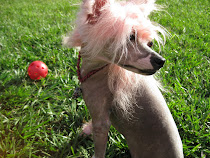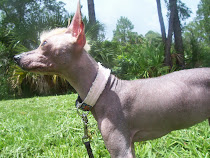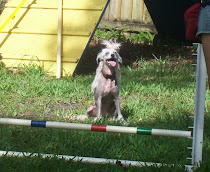Thursday, March 19, 2009
Many people have never thought to give their dog a carrot or a green bean. Just as fruits and vegetables are good for us, they are also good for dogs, too. While not all dogs go crazy for a crunchy veggie snack, you may find that your dog just might prefer a carrot to a greasy, commercially-prepared preservative-laden treat made from ground corn and heavy sugars.
I start my dogs out eating fruits and vegetables from puppyhood, and rescues from the time they come to me. It is a good idea to ask your veterinarian what fruits and vegetables he/she recommends for your dog. There are some important things to remember when feeding fruits, for example. Most fruit seeds/pits are toxic to dogs and actually contain cyanide. When giving apples, always remember to remove the seeds first. While bananas are a favorite around here, be sure to feed them in moderation as they can cause constipation and/or diarrhea depending on how much you feed. Grapes are a no-no, as are raisins. Check with your vet if you feel you need help formulating a safe list of fruits and veggies for your dog. A few common fruits and vegetables I use are potatoes (white, red and sweet), carrots, garlic, green beans, apples, bananas and tomatoes. I use organic, but if you are using non-organic, make sure to wash the fruits and vegetables thoroughly and peel them.When adding to my protein/rice/pasta base I usually use fruits in the mornings along with oatmeal and yogurt, blended in the blender. I call this concoction Fruit/Veggie Slop or Soup. :-) Any extras are placed into a ziplock container for use the next meal. 

Cottage cheese and tofu are good sources of protein that I utilize at breakfast time as well, along with hard-boiled eggs. I add all supplements in the mornings. When you are making your own dog food, it is a good idea to purchase a good quality multivitamin and mineral supplement to make up any deficiencies in your dog's diet and help in maintaining a gorgeous coat, healthy skin and eyes. I have long used The Missing Link and have been very satisfied with the results, but there are several other brands out there that are worth looking into as well. I have also used peanut oil, wild-caught salmon oil and flax oil for dogs who need a boost in the skin and coat department. Be careful not to use too much of any one particular supplement. If you are using a product such as The Missing Link, it will be unnecessary to add any extra oils as this can lead to over-supplementation.
By the time everything is mixed together it looks rather icky, but trust me, dogs go nuts for it. At dinner time, I utilize vegetables in place of the fruits. There is no law that says you can't use veggies in the morning and fruits in the evening; this is just the way I do it. Remember, try to keep a good ratio of protein to everything else. I generally go with a 70/30 split. Working dogs, young puppies and pregnant/lactating females may need more and you will need to adjust the diet in these cases.Next: Kibble
Tuesday, March 17, 2009
First let me state that I am not a canine nutritional expert or a veterinarian. My way of feeding my dogs is just that--my way. There are many other diets out there and many opinions on this subject. I am simply offering what I have learned over the course of many years of preparing my dogs' meals.
While the prospect of making your own dog food and being responsible for your dog's nutritional needs rather than blindly relying on what's inside a bag or can may sound daunting, it is something that--once you do it a few times--will help you to gain confidence and feel much better about taking that big step.
First decide whether you will be feeding a raw, modified raw or a cooked diet. There are many resources for each on the internet. There are many pros and cons for each method and everyone has their own opinions and ideas on what they feel comfortable doing. I myself feed a modified raw diet. My dogs get raw meaty bones, raw fruits and veggies, semi-cooked meats and cooked pastas. They also get cottage cheese, yogurt, eggs, ground eggshells and oatmeal. I also supplement with an organic kibble (both for crunch and so that they are used to eating it when we travel or have a dogsitter come in) as well as use a multivitamin supplement. More about all that later. ;-)
First we'll start with your dog's activity level and age, to determine who needs what. If you have young, active working dogs who are expending a lot of energy, their needs are going to be different than say an older, more sedentary pet dog. Puppies need more protein than older dogs. I generally like a 70/30 mix. 70 percent protein, 30 percent everything else. Take a look at the ingredient lists of several different bags and cans of premium commercial dog food. While many of the feeding suggestions should definately be taken as a guide and not gospel, look at the differences between Puppy, Adult and Senior diets. This will help you as you formulate the appropriate protein ratio for your dog's diet. If you have multiple dogs of different ages/dietary requirements, this can get a little trickier. No worries, though. You can do it! ;-)
As we know, dogs are carnivores. While it is possible to feed a dog a vegetarian diet with substituted proteins, we will not be addressing that here. Here we will be addressing the average household dog and how we can feed them a well-balanced homemade diet that's not only good for them, but palatable as well. So on to the first ingredient--meat!

Organic vs non-organic. I am a believer in organics. I feed my family organically and this includes the pets whenever possible. Getting your hands on organic meats can be difficult, however. While organic meats are more expensive than conventional meats, they are free of growth hormones, pesticide and antibiotic residues and other chemicals that I would rather not put into my body or my dog's. Sometimes, however, organic or natural meats are not easily accessible and we must settle for what we can get at the local store. I generally prepare my dog food for the week, so I shop for meats for the dogs while I do my regular grocery shopping. I have been very pleased to find that some of the larger chain superstores now carry a pretty good selection of organic and natural meats, and the prices are getting better. There are those times, though, when I can't find what I need in the organic or natural section and occasionally have to settle for non-organic.
Single vs multiple proteins. A single-protein diet is, in my opinion, not the best way to go. I prefer to rotate proteins. Beef one or two days, turkey the next, fish (wild-caught not farm-raised) the next, etc. I have found that by introducing a young pup to as many different protein sources as possible helps to minimize sensitivities to any one particular protein. Chicken, for example, tends to be a protein that many dogs have problems tolerating. I fed chicken until a few years ago, when tainted chicken began entering the food supply and became big news. I'd not had a problem before and all of a sudden the dogs started exhibiting strange symptoms. I eliminated the chicken and everything went back to normal. I have tried some organic chicken since but they just don't seem to tolerate it as well so I just don't use it. There are many dogs, however, that do just fine with it. You will learn what your dog tolerates well and what he/she does not.
Certain breeds may be sensitive to certain proteins as well. Chinese Cresteds are said to be prone to lamb sensitivity, so I avoid using lamb in my Crested kids' diets. My non-Cresteds do well on it. Do a little research to see if your breed has any specific dietary allergens.
Beef is a staple around here. There are many parts of the cow that are useful in canine diets, such as tripe (stomach), intestines, heart, tongue, cheekmeat and liver. Go sparingly with liver, however, as it can cause loose stools if you feed too much. I generally save liver for making dog training treats. It is something that they only get while training, and they love it, hence it remains a special once-in-a-while treat.
Fish is also a favorite protein, as it is packed with omega-3 fatty acids. All those fish oils make for a fabulously shiny coat. Ever see the containers of fish oil for sale in pet stores? It's a fabulous supplement. I have long used fish and fish oils for beautiful coats. It never disappoints. ;-) While fresh, wild-caught fish is the best, in a pinch you can use canned. I generally use salmon, but catfish, tuna, mackerel, cod and many others are good to use as well. After choosing a particular protein, I pair it with rice or some variety of pasta. Rice is my first choice, but the dogs love various pastas and tolerate them well so I do rotate different types of pastas. These days you can get organic rice and pasta quite reasonably at most grocery stores. I have a huge pot (my dog food pot as it has come to be known) and I will start the meat in some water first. As the meat is nearly done, I will add the rice or pasta. You can either slice the meat raw or slice it afterward. I generally take the time to slice it up raw, so that when I am preparing individual meals, I just scoop out what I need, without having to slice it up as I am making each bowl. Impatient dogs will generally drive me crazy if I do that. ;-)Stay tuned for the next installment!
Tuesday, March 10, 2009
Making my own dog food was something I'd learned years ago, shortly after adopting my first Rottweiler, a rescue dog in very poor health. I was working both at a veterinary hospital and a large chain pet superstore and had the benefit of being exposed to many different types of dog foods on one hand and on the other seeing the results of poor diets every day at the hospital. Poor skin and coat condition, dull eyes, flea investation and general overall health can be linked to a dog's diet.
I began making my own dog food in the early 90's after becoming involved in rescue and generally being dissatisfied with most of the dog foods on the market at the time. It was incredibly daunting in the beginning, as there were not as many websites devoted to canine nutrition as there are now. I studied a lot of pet food bags, spoke to a lot of seasoned dog people who were knowledgeable in this area, read a lot of articles, consulted veterinarians and experimented a lot. But even now, in a sea of websites on the subject, it can still be daunting. With many improvements having been made in the dog foods available today, we have many more choices than just a few years ago. Due to the more recent pet food recalls, however, many people are choosing to make their own dog food.
I have been asked many times what I feed my own dogs. In the next few articles I will outline the diet I have used with great success and hopefully make the prospect of making one's own dog food a little less daunting for those who'd like to try it. Stay tuned!
The winner for February's themed Photo Contest is Tre and his mom Patti. The theme for the month was "I Love You" and we felt that this photo--taken on Tre's Gotcha Day--embodied everything we were looking for. It just so happens that it's the one year anniversary of Tre's Gotcha Day! Congratulations Tre!
Patti has an awesome eco-conscious pet-related business, too! Check out her awesome recycled t-shirt jammies here and get some for your 4-leggeds today!









































